Impact of Mining Methods and Mine Types on Heavy Metal (Loid) Contamination in Mine Soils: A Multi-Index Assessment
Abstract
1. Introduction
2. Materials and Methods
2.1. Materials
2.1.1. Overview of the Study Area
2.1.2. Soil Sampling and Processing
2.2. Methods
2.2.1. Single Factor Pollution Index
2.2.2. Nemerow Comprehensive Pollution Index
2.2.3. Geo-Accumulation Index
2.2.4. Potential Ecological Risk Index
2.2.5. Health Risk Index
- Non-carcinogenic risk
- 2.
- Carcinogenic risk
3. Results
3.1. Assessment of Single-Factor Pollution Index
3.2. Assessment of Nemerow Comprehensive Pollution Index
3.3. Assessment of Geo-Accumulation Index
3.4. Assessment of Ecological Risk
3.5. Assessment of Health Risk Index
4. Discussion
4.1. Soil Heavy Metal Pollution of Different Mining Methods
4.2. Soils Heavy Metal Pollution of Different Mine Types
4.3. Soil Heavy Metal Pollution of Different Regions
4.4. Limitations and Prospects
5. Conclusions
Supplementary Materials
Author Contributions
Funding
Data Availability Statement
Conflicts of Interest
References
- Chen, L.; Zhou, M.; Wang, J.; Zhang, Z.; Duan, C.; Wang, X.; Zhao, S.; Bai, X.; Li, Z.; Li, Z. A Global Meta-Analysis of Heavy Metal (Loid) S Pollution in Soils Near Copper Mines: Evaluation of Pollution Level and Probabilistic Health Risks. Sci. Total Environ. 2022, 835, 155441. [Google Scholar] [CrossRef]
- Chen, Z.; Yang, Y.; Zhou, L.; Hou, H.; Zhang, Y.; Liang, J.; Zhang, S. Ecological Restoration in Mining Areas in the Context of the Belt and Road Initiative: Capability and Challenges. Environ. Impact Assess. Rev. 2022, 95, 106767. [Google Scholar] [CrossRef]
- Acosta, J.A.; Faz, A.; Martínez-Martínez, S.; Zornoza, R.; Carmona, D.M.; Kabas, S. Multivariate Statistical and GIS-Based Approach to Evaluate Heavy Metal Behavior in Mine Sites for Future Reclamation. J. Geochem. Explor. 2011, 109, 8–17. [Google Scholar] [CrossRef]
- Liu, R.; Xu, Y.; Zhang, J.; Wang, W.; Elwardany, R.M. Effects of Heavy Metal Pollution On Farmland Soils and Crops: A Case Study of the Xiaoqinling Gold Belt, China. China Geol. 2020, 3, 402–410. [Google Scholar] [CrossRef]
- Ali, H.; Khan, E.; Ilahi, I. Environmental Chemistry and Ecotoxicology of Hazardous Heavy Metals: Environmental Persistence, Toxicity, and Bioaccumulation. J. Chem. 2019, 2019, 6730305. [Google Scholar] [CrossRef]
- Søndergaard, J.; Mosbech, A. Mining Pollution in Greenland-the Lesson Learned: A Review of 50 Years of Environmental Studies and Monitoring. Sci. Total Environ. 2022, 812, 152373. [Google Scholar] [CrossRef]
- Zhang, J.; Liu, Z.; Tian, B.; Li, J.; Luo, J.; Wang, X.; Ai, S.; Wang, X. Assessment of Soil Heavy Metal Pollution in Provinces of China Based On Different Soil Types: From Normalization to Soil Quality Criteria and Ecological Risk Assessment. J. Hazard. Mater. 2023, 441, 129891. [Google Scholar] [CrossRef]
- Zhao, F.; Ma, Y.; Zhu, Y.; Tang, Z.; McGrath, S.P. Soil Contamination in China: Current Status and Mitigation Strategies. Environ. Sci. Technol. 2015, 49, 750–759. [Google Scholar] [CrossRef] [PubMed]
- Qin, F.; Wei, C.; Zhong, S.; Huang, X.; Pang, W.; Jiang, X. Soil Heavy Metal (Loid) S and Risk Assessment in Vicinity of a Coal Mining Area from Southwest Guizhou, China. J. Cent. South Univ. 2016, 23, 2205–2213. [Google Scholar] [CrossRef]
- Zhang, Y.; Li, T.; Guo, Z.; Xie, H.; Hu, Z.; Ran, H.; Li, C.; Jiang, Z. Spatial Heterogeneity and Source Apportionment of Soil Metal (Loid) S in an Abandoned Lead/Zinc Smelter. J. Environ. Sci. 2023, 127, 519–529. [Google Scholar] [CrossRef]
- Teng, Y.; Wu, J.; Lu, S.; Wang, Y.; Jiao, X.; Song, L. Soil and Soil Environmental Quality Monitoring in China: A Review. Environ. Int. 2014, 69, 177–199. [Google Scholar] [CrossRef]
- Li, X.; Zhang, X.; Du, H.-R.; Cao, J.-B. An Analysis of Dynamic Econometric on the Impact of Mineral Resource Exploitation on the Region Development—Take Xinjiang as an Example. J. Nat. Resour. 2010, 25, 1823–1833. (In Chinese) [Google Scholar]
- Xiao, P.; Zhou, Y.; Li, X.; Xu, J.; Zhao, C. Assessment of Heavy Metals in Agricultural Land: A Literature Review Based on Bibliometric Analysis. Sustainability 2021, 13, 4559. [Google Scholar] [CrossRef]
- Jin, L.; Wenjing, L.; Yang, J.; Li, Y.; Yaning, F.; Tao, T.; Xiaomeng, L. Ecolcgical and Health Risk Assessment of Heavy Metals in Farmland Soil Around the Gold Mining Area in Tongguan of Shaanxi Province. Geol. China 2021, 48, 749–763. [Google Scholar] [CrossRef]
- Zhong, X.; Chen, Z.; Li, Y.; Ding, K.; Liu, W.; Liu, Y.; Yuan, Y.; Zhang, M.; Baker, A.J.; Yang, W. Factors Influencing Heavy Metal Availability and Risk Assessment of Soils at Typical Metal Mines in Eastern China. J. Hazard. Mater. 2020, 400, 123289. [Google Scholar] [CrossRef]
- Shi, J.; Zhao, D.; Ren, F.; Huang, L. Spatiotemporal Variation of Soil Heavy Metals in China: The Pollution Status and Risk Assessment. Sci. Total Environ. 2023, 871, 161768. [Google Scholar] [CrossRef] [PubMed]
- Zhang, Y.; Song, B.; Zhou, Z. Pollution Assessment and Source Apportionment of Heavy Metals in Soil From Lead–Zinc Mining Areas of South China. J. Environ. Chem. Eng. 2023, 11, 109320. [Google Scholar] [CrossRef]
- Hua, C.; Zhou, G.; Yin, X.; Wang, C.; Chi, B.; Cao, Y.; Wang, Y.; Zheng, Y.; Cheng, Z.; Li, R. Assessment of Heavy Metal in Coal Gangue: Distribution, Leaching Characteristic and Potential Ecological Risk. Environ. Sci. Pollut. Res. 2018, 25, 32321–32331. [Google Scholar] [CrossRef] [PubMed]
- Yao, F.; Bao, A.M.; Jiapaer, G.; Yin, J.; Li, C.; Zhang, G. Soil Heavy Metal Sources and Pollution Assessment in the Coalfield of East Junggar Basin in XinJiang. China Environ. Sci. 2013, 33, 1821–1828. (In Chinese) [Google Scholar]
- Li, C.; Zhang, G.S.; Yao, F.; Wang, Y.; Li, H.D. Assessment of Soil Heavy Metal Pollution in Area of Xinjiang Zhundong Wucaiwan Surface Coal Mine. Environ. Eng. 2014, 32, 142–146. [Google Scholar] [CrossRef]
- Liao, G.; Liao, D.; Li, Q. Heavy Metals Contamination Characteristics in Soil of Different Mining Activity Zones. Trans. Nonferrous Met. Soc. China 2008, 18, 207–211. [Google Scholar] [CrossRef]
- Li, X.; Tang, Z.; Chu, F.; Yang, L. Characteristics of Distribution and Chemical Speciation of Heavy Metals in Environmental Mediums Around Jinchang Mining City, Northwest China. Environ. Earth Sci. 2011, 64, 1667–1674. [Google Scholar] [CrossRef]
- Gao, Y.; Liu, H.; Liu, G. The Spatial Distribution and Accumulation Characteristics of Heavy Metals in Steppe Soils Around Three Mining Areas in Xilinhot in Inner Mongolia, China. Environ. Sci. Pollut. Res. 2017, 24, 25416–25430. [Google Scholar] [CrossRef]
- Yu, H.; Zahidi, I. Spatial and Temporal Variation of Vegetation Cover in the Main Mining Area of Qibaoshan Town, China: Potential Impacts From Mining Damage, Solid Waste Discharge and Land Reclamation. Sci. Total Environ. 2023, 859, 160392. [Google Scholar] [CrossRef]
- Zhang, W.; You, M.; Hu, Y. The Distribution and Accumulation Characteristics of Heavy Metals in Soil and Plant from H Uainan Coalfield, C Hina. Environ. Prog. Sustain. Energy 2016, 35, 1098–1104. [Google Scholar] [CrossRef]
- Zhang, X.; Yang, H.; Cui, Z. Evaluation and Analysis of Soil Migration and Distribution Characteristics of Heavy Metals in Iron Tailings. J. Clean. Prod. 2018, 172, 475–480. [Google Scholar] [CrossRef]
- Liu, J.; Li, R.; Liang, Y.; Liu, L.; Yin, F.; Tang, S.; He, L.; Zhang, Y. Soil Cadmium Prediction and Health Risk Assessment of an Oasis On the Eastern Edge of the Tarim Basin Based On Feature Optimization and Machine Learning. Huan Jing Ke Xue Huanjing Kexue 2024, 45, 4802–4811. [Google Scholar] [CrossRef]
- Zhao, K.; Zhang, L.; Dong, J.; Wu, J.; Ye, Z.; Zhao, W.; Ding, L.; Fu, W. Risk Assessment, Spatial Patterns and Source Apportionment of Soil Heavy Metals in a Typical Chinese Hickory Plantation Region of Southeastern China. Geoderma 2020, 360, 114011. [Google Scholar] [CrossRef]
- Hou, D.; O’Connor, D.; Nathanail, P.; Tian, L.; Ma, Y. Integrated GIS and Multivariate Statistical Analysis for Regional Scale Assessment of Heavy Metal Soil Contamination: A Critical Review. Environ. Pollut. 2017, 231, 1188–1200. [Google Scholar] [CrossRef] [PubMed]
- Ma, L.; Sun, J.; Yang, Z.; Wang, L. Heavy Metal Contamination of Agricultural Soils Affected by Mining Activities Around the Ganxi River in Chenzhou, Southern China. Environ. Monit. Assess. 2015, 187, 731. [Google Scholar] [CrossRef]
- Neeraj, A.; Hiranmai, R.Y.; Iqbal, K. Comprehensive Assessment of Pollution Indices, Sources Apportionment and Ecological Risk Mapping of Heavy Metals in Agricultural Soils of Raebareli District, Uttar Pradesh, India, Employing a GIS Approach. Land Degrad. Dev. 2023, 34, 173–195. [Google Scholar] [CrossRef]
- Wei, P.; Shao, T.; Wang, R.; Chen, Z.; Zhang, Z.; Xu, Z.; Zhu, Y.; Li, D.; Fu, L.; Wang, F. A Study On Heavy Metals in the Surface Soil of the Region Around the Qinghai Lake in Tibet Plateau: Pollution Risk Evaluation and Pollution Source Analysis. Water 2020, 12, 3277. [Google Scholar] [CrossRef]
- Carrión Paladines, V.; Calva, J.; Ochoa Pérez, T.; Ruiz, L.; López Rodríguez, F. Heavy Metal Contamination in Arenillas Ecological Reserve Soils: Correlation and Conservation Impact. Land Degrad. Dev. 2025, 36, 3454–3471. [Google Scholar] [CrossRef]
- Chen, Y.; Jiang, X.; Wang, Y.; Zhuang, D. Spatial Characteristics of Heavy Metal Pollution and the Potential Ecological Risk of a Typical Mining Area: A Case Study in China. Process Saf. Environ. Protect. 2018, 113, 204–219. [Google Scholar] [CrossRef]
- Akoto, R.; Anning, A.K. Heavy Metal Enrichment and Potential Ecological Risks From Different Solid Mine Wastes at a Mine Site in Ghana. Environ. Adv. 2021, 3, 100028. [Google Scholar] [CrossRef]
- Hakanson, L. An Ecological Risk Index for Aquatic Pollution Control. A Sedimentological Approach. Water Res. 1980, 14, 975–1001. [Google Scholar] [CrossRef]
- Wang, F.; Guan, Q.; Tian, J.; Lin, J.; Yang, Y.; Yang, L.; Pan, N. Contamination Characteristics, Source Apportionment, and Health Risk Assessment of Heavy Metals in Agricultural Soil in the Hexi Corridor. Catena 2020, 191, 104573. [Google Scholar] [CrossRef]
- Yang, Q.; Li, Z.; Lu, X.; Duan, Q.; Huang, L.; Bi, J. A Review of Soil Heavy Metal Pollution From Industrial and Agricultural Regions in China: Pollution and Risk Assessment. Sci. Total Environ. 2018, 642, 690–700. [Google Scholar] [CrossRef] [PubMed]
- Panqing, Y.; Abliz, A.; Xiaoli, S.; Aisaiduli, H. Human Health-Risk Assessment of Heavy Metal–Contaminated Soil Based On Monte Carlo Simulation. Sci. Rep. 2023, 13, 7033. [Google Scholar] [CrossRef]
- Wu, Y.; Li, X.; Yu, L.; Wang, T.; Wang, J.; Liu, T. Review of Soil Heavy Metal Pollution in China: Spatial Distribution, Primary Sources, and Remediation Alternatives. Resour. Conserv. Recycl. 2022, 181, 106261. [Google Scholar] [CrossRef]
- Cao, L.; Xiang, H.; Yang, P.; Zhang, Z.; He, C.; Lin, C.; Gao, Y.; Li, Y.; Bernhardt, T.M. Towards Sustainable and Efficient Land Development: Risk of Soil Heavy Metal (Loid) S in Abandoned Gold Mines with Short-Term Rehabilitation and Potential Value for Targeted Remediation. Land Degrad. Dev. 2022, 33, 3855–3869. [Google Scholar] [CrossRef]
- Long, X.; Liu, W.; Qiu, R. Research Progress and Prospects of Human Health Risk Assessment of Heavy Metal Pollution in Farmland Soils of China. Acta Pedol. Sin. 2024, 61, 1–13. [Google Scholar] [CrossRef]
- Peng, J.; Zhang, S.; Han, Y.; Bate, B.; Ke, H.; Chen, Y. Soil Heavy Metal Pollution of Industrial Legacies in China and Health Risk Assessment. Sci. Total Environ. 2022, 816, 151632. [Google Scholar] [CrossRef] [PubMed]
- Huang, J.; Wu, Y.; Sun, J.; Li, X.; Geng, X.; Zhao, M.; Sun, T.; Fan, Z. Health Risk Assessment of Heavy Metal (Loid) S in Park Soils of the Largest Megacity in China by Using Monte Carlo Simulation Coupled with Positive Matrix Factorization Model. J. Hazard. Mater. 2021, 415, 125629. [Google Scholar] [CrossRef]
- Yu, G.; Chen, F.; Zhang, H.; Wang, Z. Pollution and Health Risk Assessment of Heavy Metals in Soils of Guizhou, China. Ecosyst. Health Sustain. 2021, 7, 1859948. [Google Scholar] [CrossRef]
- Li, Y.; Xue, J.; Cai, J.; Zhang, Y.; Li, F.; Zha, X.; Fang, G. The Spatial Distribution and Influencing Factors of Heavy Metals in Soil in Xinjiang, China. Sustainability 2023, 15, 16379. [Google Scholar] [CrossRef]
- Yang, S.; Sun, L.; Sun, Y.; Song, K.; Qin, Q.; Zhu, Z.; Xue, Y. Towards an Integrated Health Risk Assessment Framework of Soil Heavy Metals Pollution: Theoretical Basis, Conceptual Model, and Perspectives. Environ. Pollut. 2023, 316, 120596. [Google Scholar] [CrossRef]
- Changyu, W.A.; Yongli, L.I.; Wenhui, Z.H.; Lei, M.A.; Zhen, L.U.; Haoyuan, H.U.; Xin, D.U.; Peng, B.I.; Qi, G.A. Determination of multiple elements in soils surrounding iron deposits from Guyang county, Baotou city, and health risk assessment. Rock Miner. Anal. 2022, 41, 476–487. [Google Scholar] [CrossRef]
- Zhang, H.; Zhang, F.; Song, J.; Tan, M.L.; Johnson, V.C. Pollutant Source, Ecological and Human Health Risks Assessment of Heavy Metals in Soils From Coal Mining Areas in Xinjiang, China. Environ. Res. 2021, 202, 111702. [Google Scholar] [CrossRef]
- Jiang, X.; Lu, W.X.; Zhao, H.Q.; Yang, Q.C.; Yang, Z.P. Potential Ecological Risk Assessment and Prediction of Soil Heavy-Metal Pollution Around Coal Gangue Dump. Nat. Hazards Earth Syst. Sci. 2014, 14, 1599–1610. [Google Scholar] [CrossRef]
- Komnitsas, K.; Modis, K. Soil Risk Assessment of as and Zn Contamination in a Coal Mining Region Using Geostatisretics. Sci. Total Environ. 2006, 371, 190–196. [Google Scholar] [CrossRef] [PubMed]
- Oh, S.J.; Irshad, M.K.; Kang, M.W.; Roh, H.; Jeon, Y.; Lee, S.S. In-Situ Physical and Chemical Remediation of Cd and Pb Contaminated Mine Soils Cultivated with Chinese Cabbage: A Three-Year Field Study. J. Hazard. Mater. 2023, 459, 132091. [Google Scholar] [CrossRef] [PubMed]
- Haghighizadeh, A.; Rajabi, O.; Nezarat, A.; Hajyani, Z.; Haghmohammadi, M.; Hedayatikhah, S.; Asl, S.D.; Beni, A.A. Comprehensive Analysis of Heavy Metal Soil Contamination in Mining Environments: Impacts, Monitoring Techniques, and Remediation Strategies. Arab. J. Chem. 2024, 17, 105777. [Google Scholar] [CrossRef]
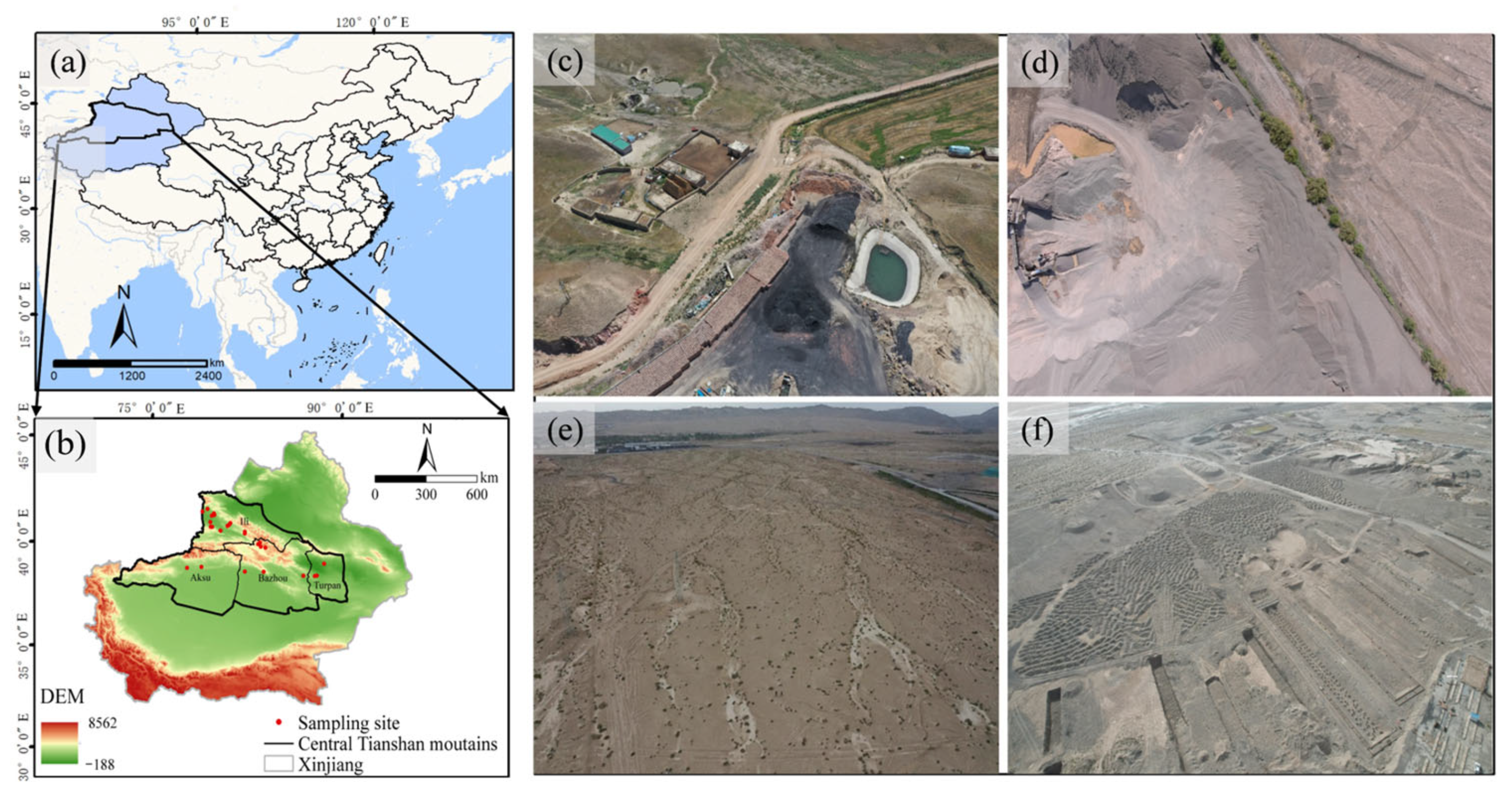
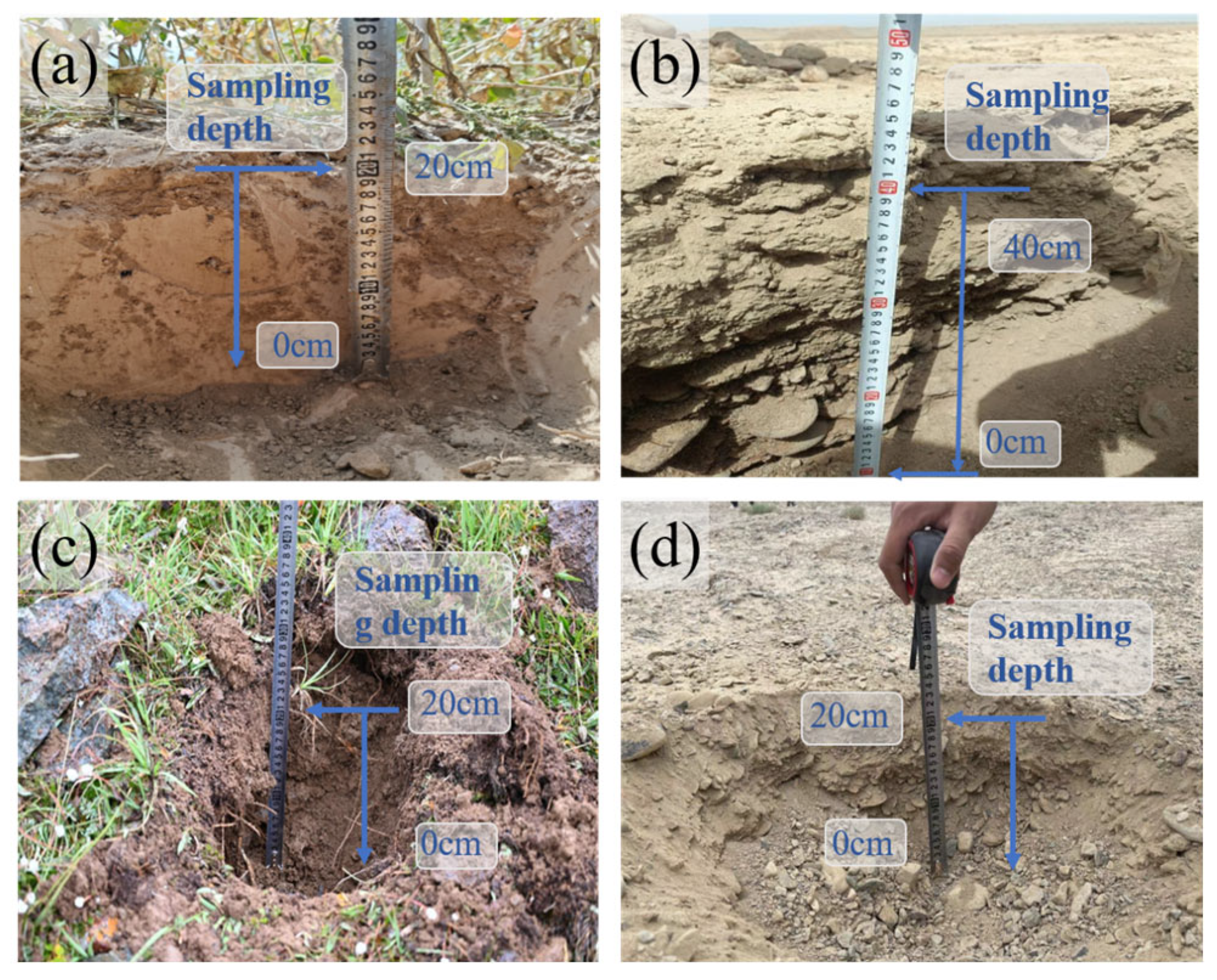
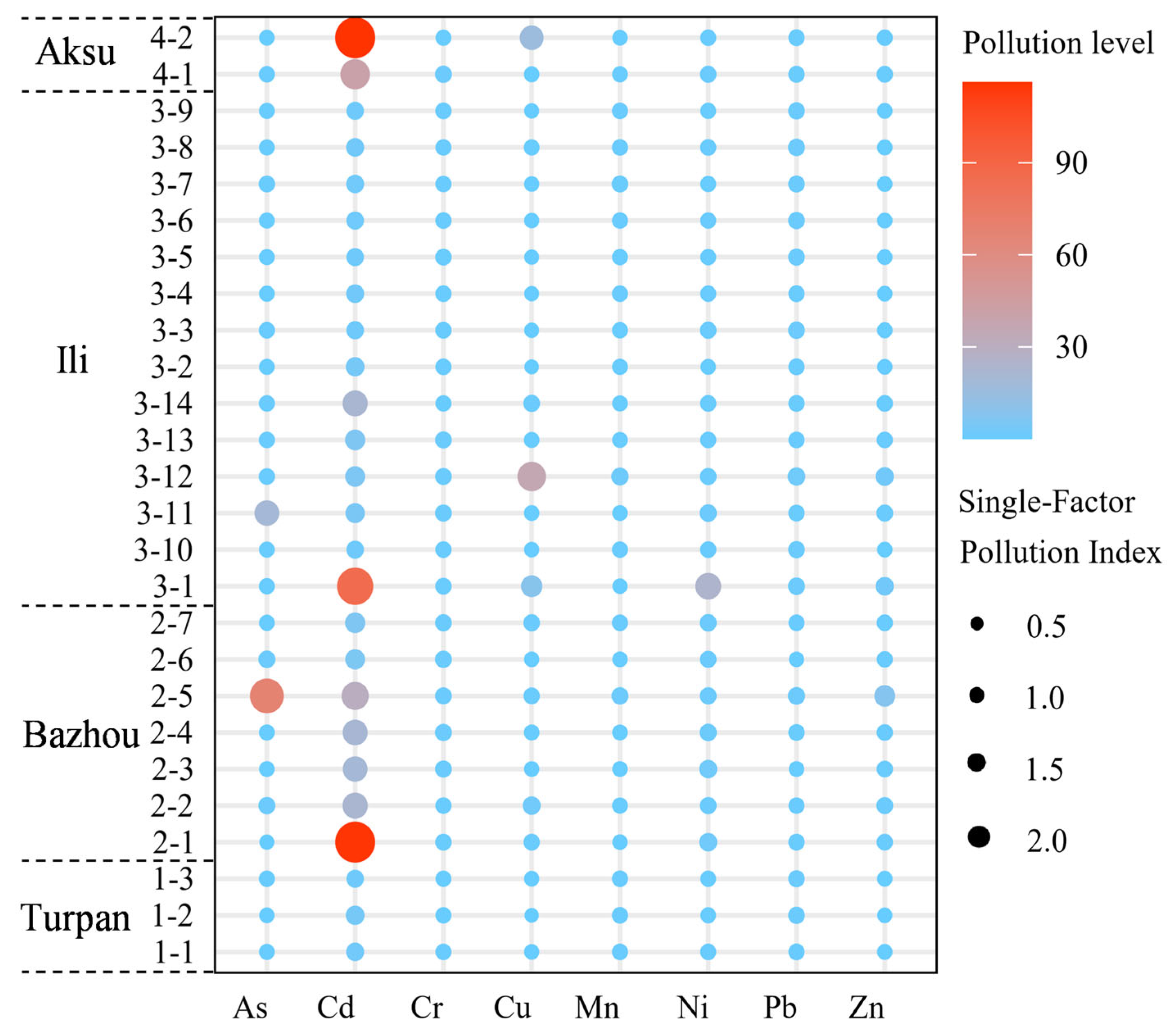


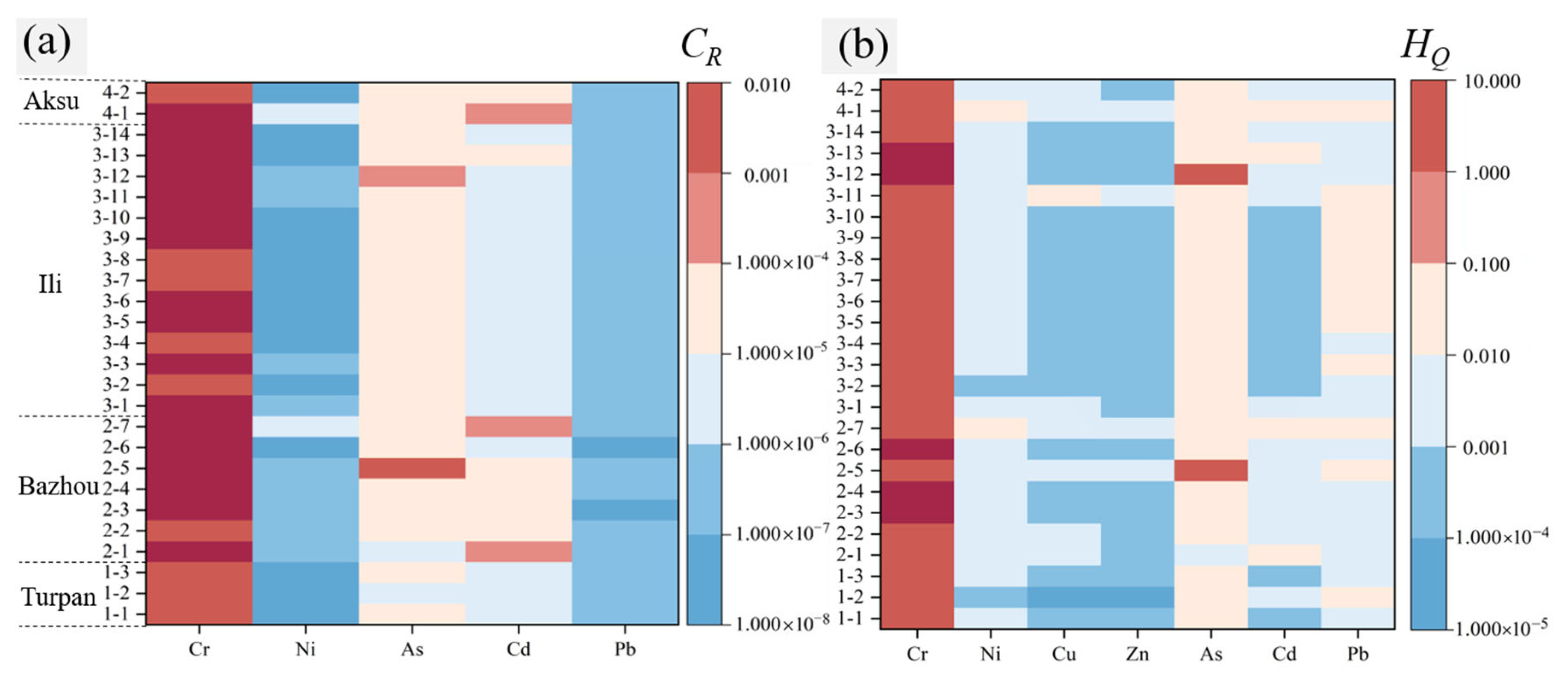
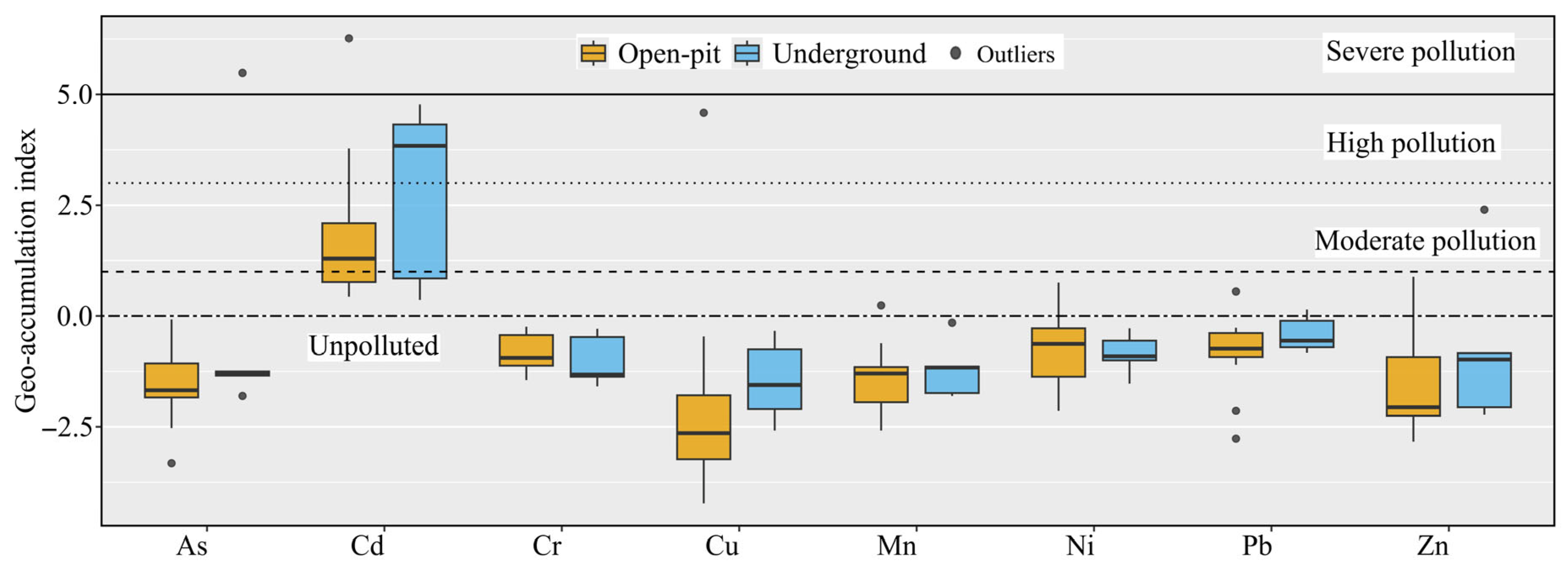
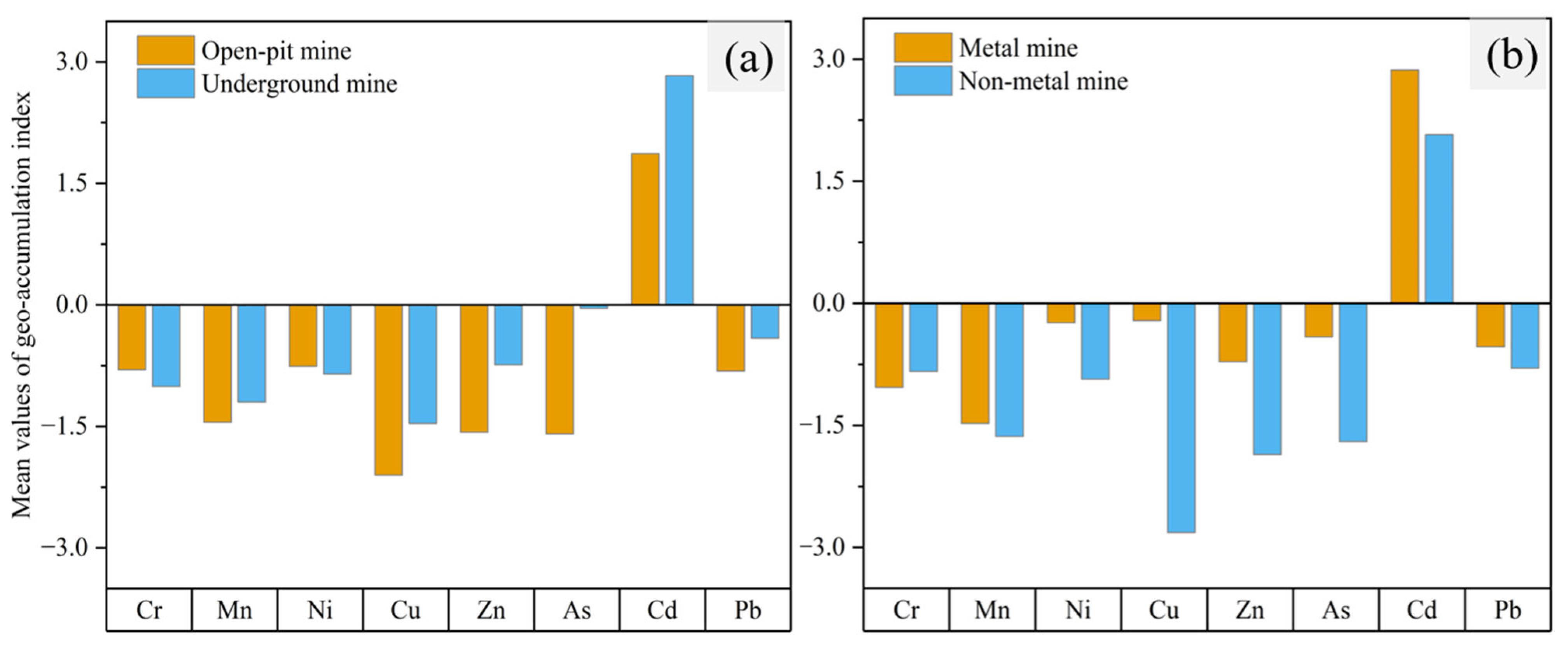
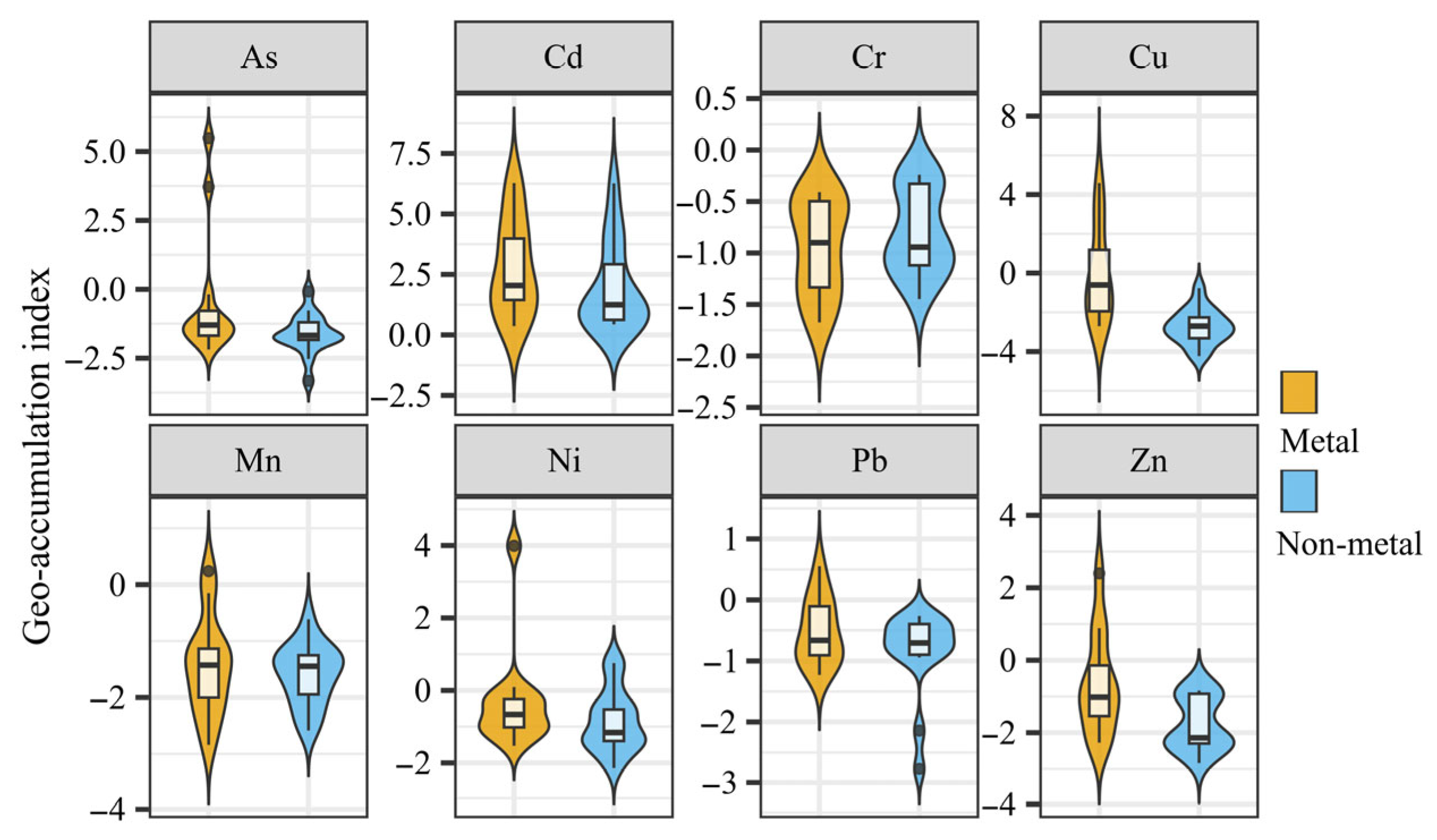
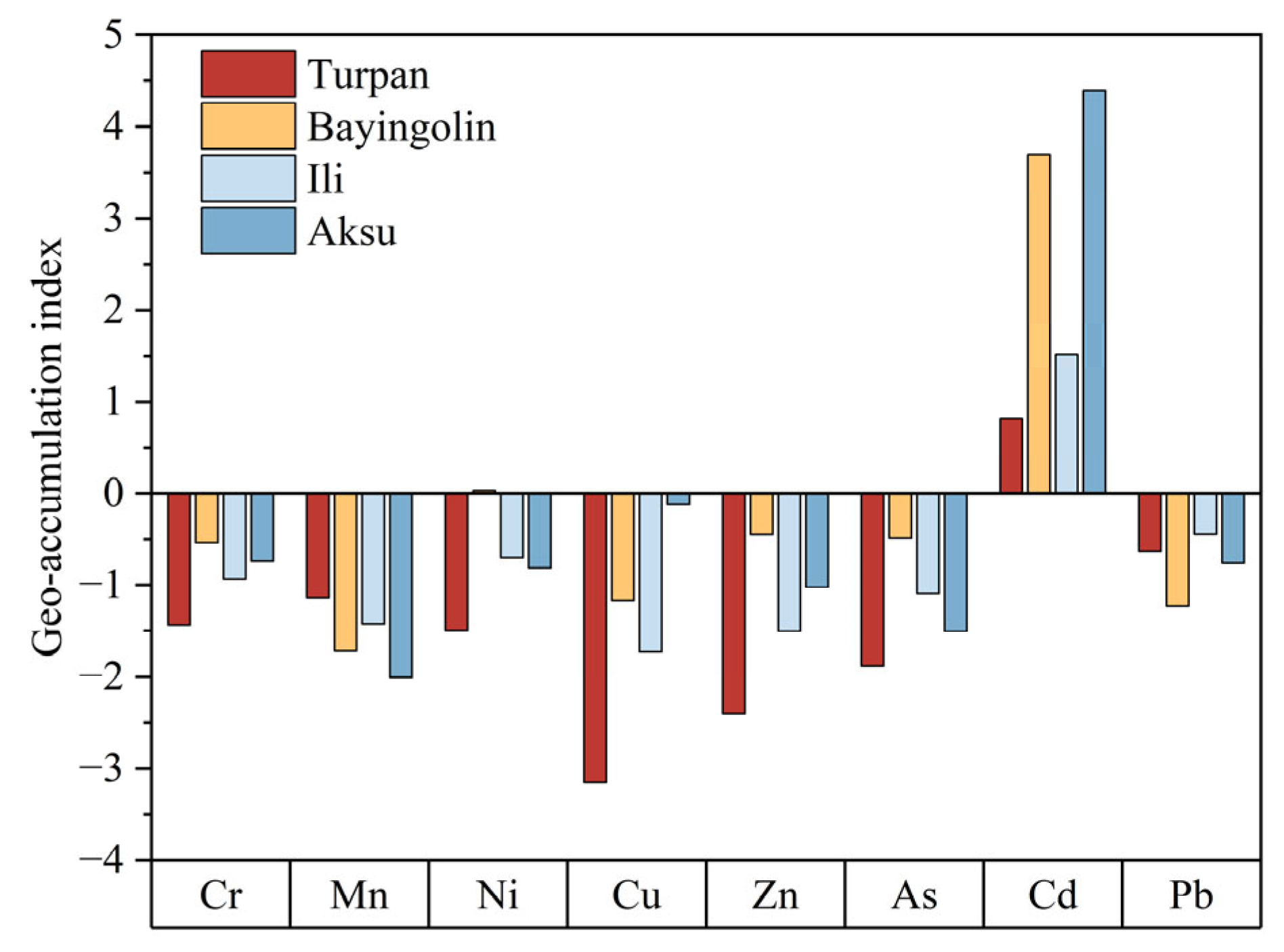
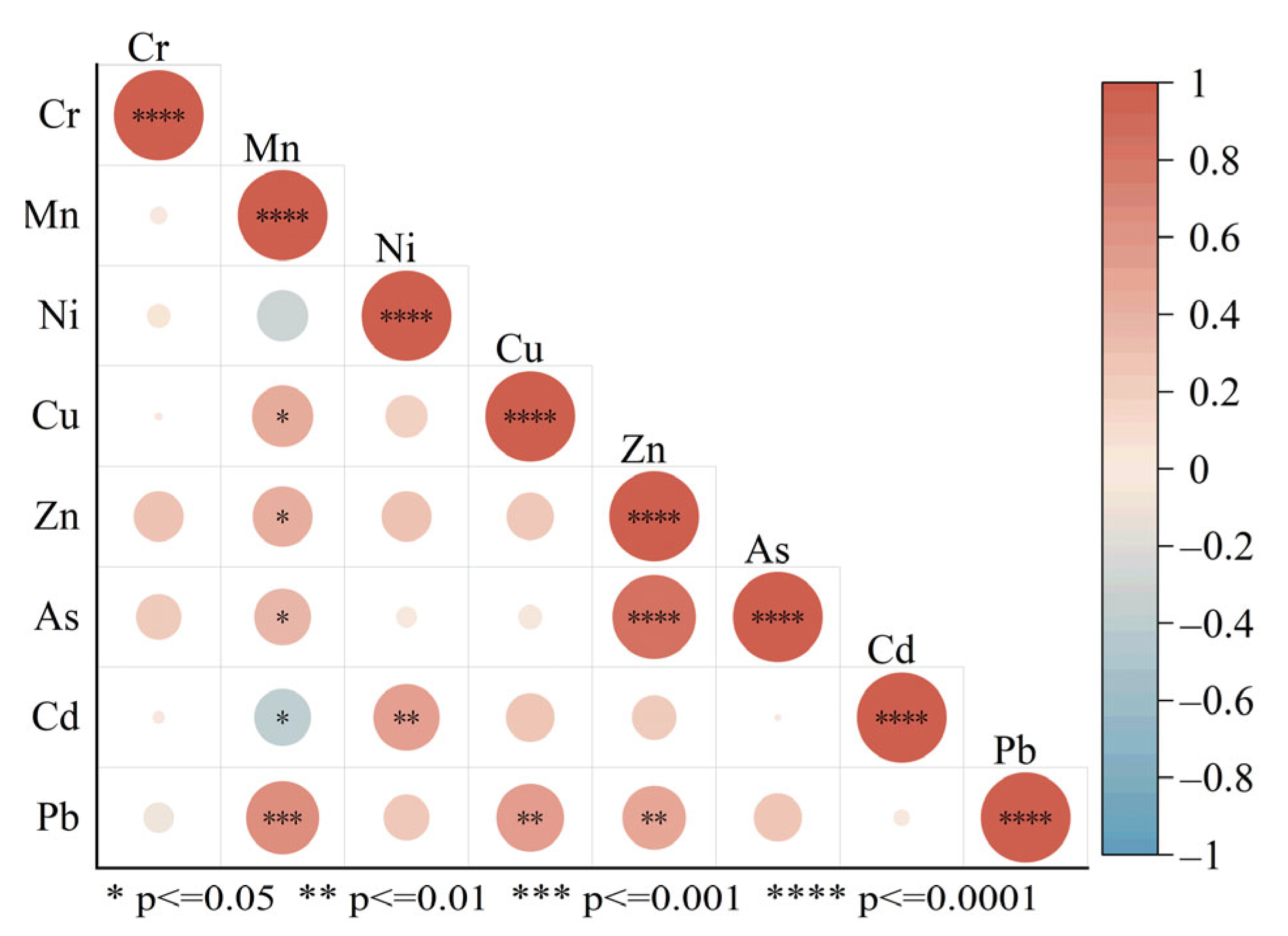
| Regions | Codes | Heavy Metal Concentration in Mine Soils (mg·kg−1) | |||||||
|---|---|---|---|---|---|---|---|---|---|
| Cr | Mn | Ni | Cu | Zn | As | Cd | Pb | ||
| Turpan | 1-1 | 30.57 | 454.08 | 17.82 | 6.41 | 23.39 | 4.93 | 0.31 | 15.13 |
| 1-2 | 27.12 | 481.60 | 11.44 | 2.14 | 14.45 | 2.91 | 0.44 | 22.12 | |
| 1-3 | 24.65 | 467.84 | 13.83 | 6.68 | 22.02 | 6.61 | 0.23 | 19.79 | |
| Mean | 27.45 | 467.84 | 14.36 | 5.08 | 19.95 | 4.82 | 0.33 | 19.01 | |
| Bazhou | 2-1 | 44.37 | 172.00 | 67.30 | 23.50 | 55.73 | 1.68 | 13.82 | 16.88 |
| 2-2 | 33.03 | 350.88 | 30.86 | 66.22 | 74.99 | 14.78 | 2.63 | 12.42 | |
| 2-3 | 57.68 | 227.04 | 66.77 | 7.48 | 57.10 | 4.14 | 2.35 | 6.60 | |
| 2-4 | 62.61 | 254.56 | 40.96 | 10.95 | 52.98 | 5.49 | 2.48 | 17.46 | |
| 2-5 | 53.24 | 928.80 | 32.98 | 23.76 | 544.21 | 752.64 | 3.60 | 32.20 | |
| 2-6 | 60.15 | 192.64 | 27.40 | 6.41 | 41.97 | 15.90 | 0.65 | 4.27 | |
| 2-7 | 52.26 | 474.72 | 36.44 | 29.10 | 49.54 | 5.26 | 0.75 | 13.58 | |
| Mean | 51.91 | 371.52 | 43.24 | 23.92 | 125.22 | 114.27 | 3.75 | 14.77 | |
| Ili | 3-1 | 42.40 | 144.48 | 634.14 | 234.16 | 180.94 | 6.16 | 10.24 | 27.35 |
| 3-2 | 34.02 | 337.12 | 9.04 | 2.40 | 19.26 | 4.59 | 0.43 | 15.71 | |
| 3-3 | 38.45 | 378.40 | 27.93 | 4.01 | 24.77 | 7.84 | 0.25 | 24.25 | |
| 3-4 | 34.02 | 419.68 | 16.23 | 4.01 | 19.26 | 4.82 | 0.32 | 15.52 | |
| 3-5 | 43.38 | 378.40 | 15.43 | 4.01 | 20.64 | 4.93 | 0.25 | 22.12 | |
| 3-6 | 36.48 | 426.56 | 15.96 | 5.61 | 23.39 | 5.26 | 0.25 | 23.47 | |
| 3-7 | 33.03 | 674.24 | 14.90 | 6.14 | 22.02 | 9.86 | 0.30 | 20.56 | |
| 3-8 | 29.58 | 460.96 | 19.95 | 13.62 | 24.77 | 4.82 | 0.32 | 26.97 | |
| 3-9 | 37.47 | 440.32 | 13.83 | 4.54 | 21.33 | 5.26 | 0.24 | 22.50 | |
| 3-10 | 36.98 | 419.68 | 21.01 | 6.14 | 21.33 | 5.15 | 0.24 | 22.70 | |
| 3-11 | 50.29 | 1217.76 | 29.79 | 962.27 | 190.58 | 8.51 | 0.68 | 42.68 | |
| 3-12 | 52.75 | 268.32 | 18.89 | 10.95 | 48.16 | 7.5 | 0.74 | 14.94 | |
| 3-13 | 55.71 | 227.04 | 42.56 | 8.81 | 74.99 | 220.98 | 0.56 | 17.07 | |
| 3-14 | 28.59 | 295.84 | 21.28 | 31.77 | 52.29 | 7.06 | 2.58 | 16.3 | |
| Mean | 39.51 | 434.91 | 64.35 | 92.75 | 53.12 | 21.62 | 1.24 | 22.30 | |
| Aksu | 4-1 | 60.64 | 309.60 | 27.13 | 9.35 | 57.79 | 6.83 | 4.91 | 17.85 |
| 4-2 | 23.17 | 192.64 | 16.76 | 436.81 | 39.90 | 3.70 | 13.94 | 15.71 | |
| Mean | 42.07 | 215.57 | 226.01 | 226.77 | 92.88 | 5.56 | 9.70 | 20.30 | |
| Construction land standard | 3.00 | / | 150.00 | 2000.00 | / | 20.00 | 0.60 | 400.00 | |
Disclaimer/Publisher’s Note: The statements, opinions and data contained in all publications are solely those of the individual author(s) and contributor(s) and not of MDPI and/or the editor(s). MDPI and/or the editor(s) disclaim responsibility for any injury to people or property resulting from any ideas, methods, instructions or products referred to in the content. |
© 2025 by the authors. Licensee MDPI, Basel, Switzerland. This article is an open access article distributed under the terms and conditions of the Creative Commons Attribution (CC BY) license (https://creativecommons.org/licenses/by/4.0/).
Share and Cite
Guo, K.; Zhang, Z.; Li, G.; Liu, H.; Wang, Z.; Fu, Y.; Wang, W. Impact of Mining Methods and Mine Types on Heavy Metal (Loid) Contamination in Mine Soils: A Multi-Index Assessment. Minerals 2025, 15, 986. https://doi.org/10.3390/min15090986
Guo K, Zhang Z, Li G, Liu H, Wang Z, Fu Y, Wang W. Impact of Mining Methods and Mine Types on Heavy Metal (Loid) Contamination in Mine Soils: A Multi-Index Assessment. Minerals. 2025; 15(9):986. https://doi.org/10.3390/min15090986
Chicago/Turabian StyleGuo, Keyan, Zizhao Zhang, Gensheng Li, Honglin Liu, Zhuo Wang, Yaokun Fu, and Wenjuan Wang. 2025. "Impact of Mining Methods and Mine Types on Heavy Metal (Loid) Contamination in Mine Soils: A Multi-Index Assessment" Minerals 15, no. 9: 986. https://doi.org/10.3390/min15090986
APA StyleGuo, K., Zhang, Z., Li, G., Liu, H., Wang, Z., Fu, Y., & Wang, W. (2025). Impact of Mining Methods and Mine Types on Heavy Metal (Loid) Contamination in Mine Soils: A Multi-Index Assessment. Minerals, 15(9), 986. https://doi.org/10.3390/min15090986











